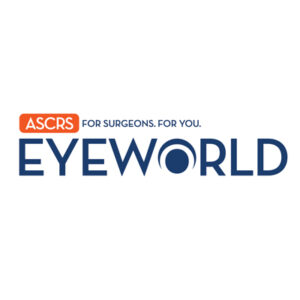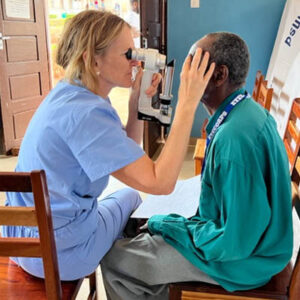Glaucoma: Research Highlight
April 2019
by Vanessa Caceres
EyeWorld Contributing Writer
Many ophthalmologists have fielded questions about marijuana use and eye health, particularly if they are in a state where medical marijuana is legal.
Now, expect to get questions about a specific component of cannabis that’s growing in popularity.
Cannabidiol, or CBD, is a chemical found in the cannabis plant. It does not make users “high,” and it has been used by many as an oil or infused into food, skin creams, and even gummies.
Under the 2018 Agriculture Act, hemp and CBD were made legal in all 50 states, although some in the medical field say there still is confusion over the specifics. Nonetheless, this has helped to set off a brigade of products and companies touting the health benefits of CBD. “This recent legislature significantly lightened the restrictions in industrial hemp, paving the way for CBD,” said Samantha Morrison.
Outside of the world of eyes, some researchers and patients have found some specific benefits for CBD. “Researchers have found that CBD has proven anti-inflammatory, antioxidant, anti-aging, and neuroprotective properties,” Ms. Morrison said. “As a result, more and more people are turning to the organic compound for treating a wide variety of ailments, including inflammation, anxiety, pain, nausea, and even neurologic disorders.”
“CBD and other cannabinoids have nice results in the reduction of anxiety and chronic pain. It is the workhorse of the cannabinoids. CBD is what does the work on reducing muscle spasms, pain, and inflammation,” said Mary Clifton, MD, who provides cannabis consultations in New York and through her virtual telemedicine portal.
In clinical trials, CBD has been shown to be an effective treatment for epilepsy, according to a report from the World Health Organization.1 Last year, the U.S. FDA approved Epidiolex (GW Pharmaceuticals), a CBD-based drug designed to treat two rare and severe forms of epilepsy. Other CBD-based drugs are under development, including Arvisol (Echo Pharmaceuticals), which is in pre-clinical testing for epilepsy and schizophrenia.
On the consumer level, CBD users are reporting that they have found relief from sleep problems, inflammation, and stress and anxiety, according to Brenda Green, MEd. There are also many who purchase CBD oil for pet anxiety or inflammation, she added. Some parents are trying CBD for attention deficit disorder in their children.
The use of CBD is most effective as a tincture (placed under the tongue) or vaped, although some consumers dislike the idea of using a vape, Ms. Green said. Jordan Tishler, MD, cautions that research on CBD dosing has shown that you cannot vape enough to get an effective treatment.
Cannabidiol has few side effects. Some studies have noted fatigue, diarrhea, and change in appetite, but these are considered rare, Ms. Morrison said.
For the eyes
Ophthalmologists may wonder how all this comes back to eye health. Because marijuana has had a long-time association with glaucoma (even if scientific evidence does not back it), medical professionals and patients tend to ponder whether CBD also can improve eye health, be it for glaucoma or other ocular issues.
The bottom line: The evidence is mixed, and it’s likely too early for a clear answer.
A 2016 Canadian study of CB1 and CB2 receptors in monkeys concluded that manipulating the endocannabinoid system may help restore normal vision and protect the retina.2
“In practice, cannabinoids help regulate the arterial tone within blood vessels in the central nervous system. This has led researchers to study the effect of cannabis on retina ischemia and retinopathy in general,” Ms. Morrison said. “Clinical trials indicate that cannabinoid receptor antagonists may inhibit cellular degeneration caused by the release of lactate dehydrogenase induced by retinal ischemia.”
A U.K. study that reviewed research on cannabinoids and glaucoma reported that because CBD has antioxidant properties not mediated by the CB1 receptor, it could prevent neuronal death by scavenging toxic reactive oxygen species produced by overstimulation of receptors for glutamic acid.3 “Perhaps the potent antioxidant properties of the cannabinoids may be beneficial in [age-related macular degeneration], offering a possible alternative to established antioxidant supplements,” the authors wrote.
“Some publications have suggested that cannabinoids can be neuroprotective, so that has some implications for retinal diseases like retinitis pigmentosa. The results are mixed, and I would say contradictory,” said Alex Straiker, PhD.
A recently published study that received attention in the consumer press focused on both CBD and Δ9-tetrahydrocannabinol (THC, the main psychoactive ingredient in cannabis) and their role in regulating IOP.4 “Over the last several years, we have determined that three different cannabinoid receptors—CB1, GPR18, and GPR119—each can lower pressure in mice when activated. Once this was established, it made sense to go back to THC and CBD to see how they act,” said Dr. Straiker, one of the study’s co-researchers. Their study provided topical application of both THC and CBD in mice, and researchers found the CBD actually raised IOP. At the same time, THC lowered IOP through a combination of CB1 and GPR18 receptors. The effect of THC was sex-dependent, with longer effects in male mice. Additionally, CBD canceled out the IOP-lowering effects of THC, probably by blocking CB1 receptors, Dr. Straiker said.
Between research and practice, for now, there is no CBD treatment recommended specifically for the eyes. “It is not an effective treatment for any ophthalmologic issues,” Dr. Tishler said. “Further, the high doses needed to see any result in illness are not achievable in eyecare.”
In her own review of the research, Dr. Clifton sees potential for CBD and certain eye health issues. “It makes sense that taken internally, it would help inflammation or pain syndromes affecting the eye, just like it does any tissue,” Dr. Clifton said. She perceived several of the previous studies conducted as biased against cannabis.
Research on CBD in the U.S. likely will expand now that it is no longer classified as a Schedule 1 drug, Mr. DeRose said (marijuana is still on the Schedule 1 list from the Drug Enforcement Act). One of many questions that could be explored with further research is what happens in subjects who smoke high-CBD varieties of cannabis, Dr. Straiker said.
In practice
Ophthalmologists can use their growing knowledge of CBD to guide patient queries appropriately, particularly in states where marijuana has been legal for a longer length of time.
“CBD is a very common topic of ongoing education throughout Colorado,” said Antonio DeRose. “This has helped reduce negative stigma and spread positive awareness for several medicinal properties, which in turn is leading more people to turn to CBD over certain prescriptions and over-the-counter medications.” However, Dr. Tishler said that this can be dangerous if done without regard to a patient’s actual medical care.
“At true treatment doses of 10–20 mg/kg, CBD can interact with conventional medications and depending on what those are, can be quite dangerous,” Dr. Tishler said.
Ophthalmologist Ray Chan, MD, receives one or two questions a month about CBD or marijuana, mostly from patients who have a stronger interest in alternative medicine. If patients are using CBD for systemic health, he advises checking with their primary care doctor to find out if it’s helpful. If it’s for eye health, “I would advise them that there is no scientific evidence that it helps the eye. There are many better and cheaper medications to treat glaucoma,” he said.
Dr. Tishler is asked frequently about CBD for sleep and pain relief, but he states the data only supports the use of THC/THC-dominant whole flower for these problems.
For those who want to delve deeper into CBD use, it’s important to learn more about dosing. Ms. Green advises CBD users to start “low and slow” but also noted that it’s easy to get the dosing wrong, which is why users should buy from retailers with extensive product knowledge. Product quality is also key. There are a lot of CBD products entering the market, but that does not necessarily mean they are all effective, Ms. Green said.
Dr. Clifton also recommends tinctures or vaping and steers patients away from edibles, which can take longer to be effective.
ARTICLE SIDEBAR
Marijuana use for glaucoma not effective
Although there’s a common perception that marijuana can help lower IOP, that is not a formal recommendation from ophthalmologists.
“We have known since 1971 that smoking marijuana does lower your eye pressure, which is the main treatment for glaucoma. However, the eye pressure lowering effect is very short acting,” Dr. Chan said. For someone to achieve a sustained IOP lowering, they need to constantly use the drug, which could lead to systemic changes to the brain, lungs, and cardiovascular system, he explained.
Cannabis for glaucoma “is entirely impractical and dangerous,” Dr. Tishler said.
In a 2014 paper, the American Academy of Ophthalmology said there is no evidence that marijuana provides an increased benefit for or diminished risk of glaucoma compared to the traditional treatments available.5
About the sources
Ray Chan, MD
Texas Health Arlington
Memorial Hospital
Arlington, Texas
Mary Clifton, MD
Internal medicine physician
New York
Antonio DeRose, NASM CPT
Green House Healthy
Boulder, Colorado
Brenda Green, MEd CBD specialist
Sarasota, Florida
Samantha Morrison
Cannabis researcher
Glacier Wellness
New York
Alex Straiker, PhD
Senior research scientist
Department of Psychological and Brain Sciences
Indiana University
Bloomington, Indiana
Jordan Tishler, MD
President, Association of Cannabis Specialists
Harvard Medical School
InhaleMD
Boston
References
- World Health Organization. Cannabidiol: Pre-review report. November 2017. https://www.ash-us.org/cannabidiol-pre-review-report-5.2/
- Bouskila J, et al. Cannabinoid receptors CB1 and CB2 modulate the electroretinographic waves in vervet monkeys. Neural Plast. 2016;2016;1253245.
- Tomida I, et al. Cannabinoids and glaucoma. Br J Ophthlamol. 2004;88:708–13.
- Miller S, et al. Δ9-tetrahydrocannabinol and cannabidiol differentially regulate intraocular pressure. Invest Ophthalmol Vis Sci. 2018;59:5904–5911.
- AAO Complementary Therapy Task Force, Hoskins Center for Quality Eye Care. Marijuana in the Treatment of Glaucoma CTA – 2014. June 2014. www.aao.org/complimentary-therapy-assessment/marijuana-in-treatment-of-glaucoma-cta–may-2003
Contact information
Chan: vp1600@yahoo.com
Clifton: marywendtmd@gmail.com
Green: beegreeninsarasota@hotmail.com
DeRose: antonio@greenhousehealthy.com
Morrison: sam@cbdirective.co
Straiker: straiker@indiana.edu
Tishler: doc@inhaleMD.com
Financial interests
Chan: None
Clifton: None
Green: None
DeRose: None
Morrison: None
Straiker: None
Tishler: None



